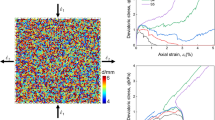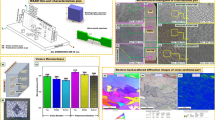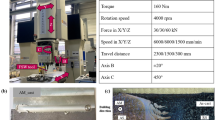Abstract
This work presents a discrete element model (DEM) of the impeller–tumbler wear test in order to investigate high-stress impact–abrasion mechanisms on steel plates with the use of abrasive granite particles. A DEM calibration procedure of the granite particles is first performed to set particle-scale DEM parameters such as particle shape, density and frictions. The simulations of the impeller–tumbler wear test showed good qualitative results with experimental observations. Simulation results demonstrate that edges of the tested steel plate samples are first abraded, as in the experiments, and a linear increase in abrasion energies cumulated with time on the steel plates is obtained which is in accordance with the linear time evolution of sample mass loss in the experiments. Simulations shed light on the particle flow and particle–wall contact behavior which was impossible to observe experimentally. Local investigations of particle–wall contacts show an exponential decay of normal contact forces classically found for static granular materials when forces are above the mean contact force. Also, tangential contact forces distribution follows an exponential decay for forces above their mean force. This work demonstrates that the exponential decay of large contact forces is a robust feature even for a dynamic and loose granular system which is a novelty. Finally, probability density functions of normal and tangential abrasion energies are found to follow exponential decays for energy data above their mean values which is for the first time observed.


















Similar content being viewed by others
References
Holmberg K, Erdemir A (2017) Influence of tribology on global energy consumption, costs and emissions. Friction 5(3):263–284
Hawk JA, Wilson RD, Tylczak JH, Doğan ÖN (1999) Laboratory abrasive wear tests: investigation of test methods and alloy correlation. Wear 225:1031–1042
Sundström A, Rendón J, Olsson M (2001) Wear behaviour of some low alloyed steels under combined impact/abrasion contact conditions. Wear 250(1–12):744–754
Ratia V, Miettunen I, Kuokkala V (2013) Surface deformation of steels in impact-abrasion: the effect of sample angle and test duration. Wear 301(1–2):94–101
Bond FC (1964) Lab equipment and tests help predict metal consumption in crushing and grinding units. Eng Min J 165(6):169–175
Bond FC (1952) The third theory of comminution. Trans Am Inst Min Metallurg Pet Eng 193(1952):484–494
Bond FC (1962) New ideas clarify grinding principles. Engineering (February 1962), 103
Ratia V, Heino V, Valtonen K, Vippola M, Kemppainen A, Siitonen P, Kuokkala V (2014) Effect of abrasive properties on the high-stress three-body abrasion of steels and hard metals. Tribologia-Finnish J Tribol 32(1):3–18
Cundall P, Strack O (1979) A discrete numerical model for granular assemblies. Geotechnique 29(1):47–65
Mueth DM, Jaeger H, Nagel SR (1998) Force distribution in a granular medium. Phys Rev E 57(3):3164
Løvoll G, Måløy K, Flekkøy EG (1999) Force measurements on static granular materials. Phys Rev E 60(5):5872
Radjai F, Roux S, Moreau JJ (1999) Contact forces in a granular packing. Chaos Interdiscip J Nonlinear Sci 9(3):544–550
Mueggenburg NW, Jaeger HM, Nagel SR (2002) Stress transmission through three-dimensional ordered granular arrays. Phys Rev E 66(3):031304
Liu C-h, Nagel SR, Schecter DA, Coppersmith SN, Majumdar S, Narayan O, Witten TA (1995) Force fluctuations in bead packs. Science 269(5223):513–515
Ben Hamouda H, Corryn M (2019) Methodology Development of an impact abrasion test with validation by comparison with real industrial case. In: Proceedings on engineering sciences (in press)
Ratia V, Valtonen K, Kemppainen A, Kuokkala V (2016) The role of edge-concentrated wear in impact-abrasion testing. Tribol Online 11(2):410–416
Terva J, Kuokkala VT, Kivikytö-Reponen P (2012) The edge effect of specimens in abrasive wear testing. Tribol-Finnish J Tribol 31(3–4):27–35
Hertz H (1895) Ueber die Beruehrung elastischer Koerper (On Contact of Elastic Bodies). Gesammelte Werke (Collected Works) 1:155–173
Hertz H (1882) Ueber die Verdunstung der Flüssigkeiten, insbesondere des Quecksilbers, im luftleeren Raume. Annalen der Physik 253(10):177–193
Mindlin RD (1949) Compliance of elastic bodies in contact. J Appl Mech ASME 16:259–268
Mindlin RD (1953) Elastic spheres in contact under varying oblique forces. J Appl Mech 20:327–344
Tsuji Y, Tanaka T, Ishida T (1992) Lagrangian numerical simulation of plug flow of cohesionless particles in a horizontal pipe. Powder Technol 71(3):239–250
DEM Solutions (2014) EDEM 2.6 theory reference guide. Edinburgh, United Kingdom
Pasha M, Hare C, Ghadiri M, Gunadi A, Piccione PM (2016) Effect of particle shape on flow in discrete element method simulation of a rotary batch seed coater. Powder Technol 296:29–36
Barrios GKP, de Carvalho RM, Kwade A, Tavares LM (2013) Contact parameter estimation for DEM simulation of iron ore pellet handling. Powder Technol 248:84–93
Mellmann J (2001) The transverse motion of solids in rotating cylinders-forms of motion and transition behavior. Powder Technol 118(3):251–270
Acknowledgements
We acknowledge Marina Sousani for her help in explaining the DEM method implemented in the EDEM software which is presented in Sect. 3.1.
Author information
Authors and Affiliations
Corresponding author
Ethics declarations
Conflict of interest
The authors declare that they have no conflict of interest.
Additional information
Publisher's Note
Springer Nature remains neutral with regard to jurisdictional claims in published maps and institutional affiliations.
Electronic supplementary material
Below is the link to the electronic supplementary material.
Supplementary material 1 (wmv 25372 KB)
Rights and permissions
About this article
Cite this article
Izard, E., Ben Hamouda, H. & Vande Voorde, J. High-stress impact–abrasion test by discrete element modeling. Comp. Part. Mech. 8, 1061–1073 (2021). https://doi.org/10.1007/s40571-020-00377-8
Received:
Revised:
Accepted:
Published:
Issue Date:
DOI: https://doi.org/10.1007/s40571-020-00377-8




